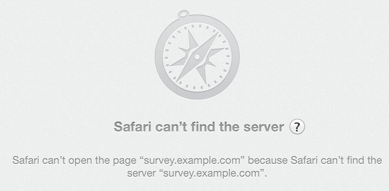Sending email
- steve
- June 14, 2022
- Delivery improvement , Technical
Recipients can’t click through if you don’t exist
A tale of misconfigured DNS wrecking someone’s campaign.
I got mail this morning from A Large Computer Supplier, asking me to fill in a survey about them. I had some feedback for them, mostly along the lines of “It’s been two decades since I bought anything other than rackmount servers from you, maybe I’m not a good advertising target for $200 consumer laptops?” so I clicked the link.

(I’ve replaced the real domain with survey.example.com in this post, to protect the innocent, but everything else is authentic).
That’s not good. The friendly error messages web browsers give sometimes hide the underlying problem, but that looks like a DNS problem. Did they do something stupid, like putting the wrong URL in the mail they sent?
I was on the phone with a colleague recently. They were talking about collecting a bit of data over the weekend and mentioned how great it was they had the tools to be able to do this. Coincidentally, another colleague mentioned that when the subscription bombing happened they were able to react quickly because they had a decent tool chain. I’ve also been working with some clients who are dealing with compliance issues but don’t have the tools they need.
Read MoreA few days ago Laura noticed a bug in one of our in-house tools – it was sometimes marking an email as SPF Neutral when it should have been a valid SPF pass. I got around to debugging it today and traced it back to a bug in the Go standard library.
Read More